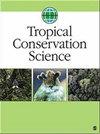Tree Species Diversity, Composition and Aboveground Biomass Across Dry Forest Land-Cover Types in Coastal Ecuador
IF 1.6
4区 环境科学与生态学
Q2 BIODIVERSITY CONSERVATION
引用次数: 1
Abstract
Tropical dry forests (TDF) are highly threatened ecosystems that are often fragmented due to land-cover change. Using plot inventories, we analyzed tree species diversity, community composition and aboveground biomass patterns across mature (MF) and secondary forests of about 25 years since cattle ranching ceased (SF), 10–20-year-old plantations (PL), and pastures in a TDF landscape in Ecuador. Tree diversity was highest in MF followed by SF, pastures and PL, but many endemic and endangered species occurred in both MF and SF, which demonstrates the importance of SF for species conservation. Stem density was higher in PL, followed by SF, MF and pastures. Community composition differed between MF and SF due to the presence of different specialist species. Some SF specialists also occurred in pastures, and all species found in pastures were also recorded in SF indicating a resemblance between these two land-cover types even after 25 years of succession. Aboveground biomass was highest in MF, but SF and Tectona grandis PL exhibited similar numbers followed by Schizolobium parahyba PL, Ochroma pyramidale PL and pastures. These findings indicate that although species-poor, some PL equal or surpass SF in aboveground biomass, which highlights the critical importance of incorporating biodiversity, among other ecosystem services, to carbon sequestration initiatives. This research contributes to understanding biodiversity conservation across a mosaic of land-cover types in a TDF landscape.厄瓜多尔沿海干旱林地覆盖类型的树种多样性、组成和地上生物量
热带干林(TDF)是高度受威胁的生态系统,由于土地覆盖的变化,这些生态系统往往是支离破碎的。使用地块清单,我们分析了厄瓜多尔TDF景观中自牧场停止(SF)以来约25年的成熟(MF)和次生林、10-20年的种植园(PL)和牧场的树种多样性、群落组成和地上生物量模式。MF的树木多样性最高,其次是SF、牧场和PL,但MF和SF都出现了许多特有和濒危物种,这表明SF对物种保护的重要性。PL的茎密度较高,其次是SF、MF和牧场。由于存在不同的专业物种,MF和SF之间的群落组成不同。一些SF专家也出现在牧场中,在牧场中发现的所有物种也都记录在SF中,这表明即使在25年的演替之后,这两种土地覆盖类型也很相似。地上生物量在MF中最高,但SF和柚木PL表现出相似的数量,其次是Schizolobium parahyba PL、Ochroma pyramidale PL和牧场。这些发现表明,尽管物种贫乏,但一些PL在地上生物量方面等于或超过SF,这突出了将生物多样性和其他生态系统服务纳入碳固存倡议的至关重要性。这项研究有助于了解TDF景观中土地覆盖类型马赛克的生物多样性保护。
本文章由计算机程序翻译,如有差异,请以英文原文为准。
求助全文
约1分钟内获得全文
求助全文
来源期刊

Tropical Conservation Science
BIODIVERSITY CONSERVATION-
CiteScore
3.60
自引率
5.90%
发文量
16
审稿时长
>12 weeks
期刊介绍:
Tropical Conservation Science is a peer-reviewed, open access journal that publishes original research papers and state-of-the-art reviews of broad interest to the field of conservation of tropical forests and of other tropical ecosystems.
 求助内容:
求助内容: 应助结果提醒方式:
应助结果提醒方式:


